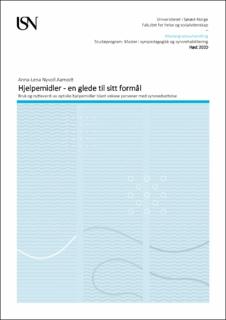| dc.contributor.advisor | Falkenberg, Helle K. | |
| dc.contributor.author | Aamodt, Anna-Lena Nyvoll | |
| dc.date.accessioned | 2023-12-21T17:41:34Z | |
| dc.date.available | 2023-12-21T17:41:34Z | |
| dc.date.issued | 2020 | |
| dc.identifier | no.usn:wiseflow:2103331:33803113 | |
| dc.identifier.uri | https://hdl.handle.net/11250/3108699 | |
| dc.description.abstract | Bakgrunn: Nedsatt syn vil føre til at oppgaver som tidligere har blitt gjennomført uten problemer blir utfordrende, og må løses på nye måter. Bruk av hjelpemidler er sentralt i synsrehabilitering og kan gi bedre synsfunksjon, effektivisere arbeidsoppgavene og kan bidra til økt selvstendighet i hverdagen.
Formål: Målet med studien var å finne ut hvilke hjelpemidler som faktisk blir brukt og hvorvidt de tildelte hjelpemidlene er nyttige for brukeren. På samme tid å kunne gi informasjon om hvilken betydning hjelpemidlene har for brukeren i hverdagen og om de har fått tilstrekkelig med opplæring i bruken av de ulike hjelpemidlene.
Metode: 80 personer ble invitert til å delta via Norges blindeforbund. 20 av 22 samtykket til å delta i strukturert telefonintervju. Intervjuene varte i gjennomsnitt 28 minutter. Studien inkluderte seks ulike hjelpemiddel og deltakerne besvarte spørsmål tilknyttet bruk, nytteverdi og opplæring for hvert enkelt hjelpemiddel. Relevant informasjon fra fritekstsvar og kommentarer ble gruppert og sett i sammenheng med talldataene.
Resultat: Totalt hadde deltakerne 78 hjelpemidler og 70 av disse var i bruk. I gjennomsnitt hadde deltakerne 4 av 6 hjelpemiddel og for hvert hjelpemiddel svarte deltakerne på mellom inntil 16 spørsmål, avhengig av om hjelpemiddelet var i bruk eller ikke. Lupestativ/lupelampe og forsterket lesebrille ble brukt av færrest (8), mens lupe og smarttelefon/iPad ble brukt av flest (16). Smarttelefon/iPad ble brukt daglig, mens kikkert/kikkertbrille var mest sjelden i bruk. Alle hjelpemidlene var svært nyttige for brukeren og antyder at selv de hjelpemidlene som blir sjelden brukt er viktige. For 59% av hjelpemidlene hadde brukeren mottatt opplæring og for 78% av disse varte opplæringen mindre enn en time. I friteksten ble tre temaer utdypet:
1) Oppfølging og opplæring, 2) Deltagelse og 3) Selvstendighet.
Konklusjon: De fleste av deltakerne hadde mange hjelpemidler. Smarttelefon/iPad og håndholdt lupe var mest brukt. De ulike hjelpemidlene hadde betydning for deltakernes selvstendighet, samt mulighet til deltagelse. Nytteverdi var ikke relatert til hyppighet i bruk, da ulike og spesifikke bruksområder krevde ulike hjelpemidler, noe som igjen indikerer viktigheten av individualisert opplæring og allsidige hjelpemidler. Det kommer frem av studien at deltakerne har mottatt lite opplæring i bruk av hjelpemidlene, og at tilbudet om oppfølging og opplæring kan variere alt etter bosted. Funnene tyder på at utnyttelsen av hjelpemidlene kunne vært enda bedre, og mer strukturert oppfølging og opplæring kan bidra til mer effektiv og nyttig bruk.
Nøkkelord: synsnedsettelse, hjelpemiddel, synsrehabilitering, selvstendighet, deltagelse | |
| dc.description.abstract | Background: Experiencing impaired vision, tasks that previously have been completed without problems becomes challenging and must be solved in new ways. Low vision aids (LVA) can improve visual function and thereby the conditions for being able to perform the task, as such are an important task of low vision rehabilitation. Good use of LVA’s can in turn can give increased independence, and improved everyday life.
Purpose: The aim was to find out which LVA’s are used by person’s with low vision, and whether the assigned LVA’s are considered useful to the user. A secondary aim was to, provide information on the significance of the aids for the user in everyday life and whether they have received enough training in the use of the various aids.
Method: 80 people were invited to participate via the Norwegian Association of the Blind. 22 agreed to participate in a structured telephone interview. The interviews lasted on average 28 minutes. The questionnaire included six different aids and the participants answered the same 16 questions, depending on how many of the aids they had. Relevant information from free text responses were used to add to the information and seen in connection with the numeric data.
Result: In total, the participants had 78 aids and 70 of these were in use. On average, participants had 4 out of 6 aids and for each aid, the participant answered up to 16 questions, depending on whether the aid was in use or not. Magnifier stand and high plus reading glasses were the least frequent aid (8), while magnifying glass and smartphone / iPad were the most frequent aids (16). Smartphone / iPad were used daily, while telescopes were most rarely used. All the aids were assessed as very useful and suggest that even the aids that are rarely used are important. For 59% of the aids, the user had received training and for 78% of these, the training lasted less than an hour. The free text comments elucidated three themes: 1) Follow-up and training, 2) Participation and 3) Independence.
Conclusion: Most of the participants had many different aids, for very different purposes. Smartphone / iPad and handheld magnifier were most frequently used. The various aids were important for the participants' independence, as well as the opportunity to participate in social and active life. Usefulness was not related to frequency of use. Different and specific areas of use required different aids, highlighting the importance of individualized training and versatile aids. The study shows that the participants have received very little training in the use of the aids, and that the offer of follow-up and training can vary depending on the place of residence. The findings suggest that the utilization of the aids could have been even better. More structured follow-up and training can contribute to more efficient use.
Keywords: Low vision, low vision aids, visual rehabilitation, participation, independence | |
| dc.language | nob | |
| dc.publisher | University of South-Eastern Norway | |
| dc.title | Hjelpemidler - en glede til sitt formål | |
| dc.type | Master thesis | |
